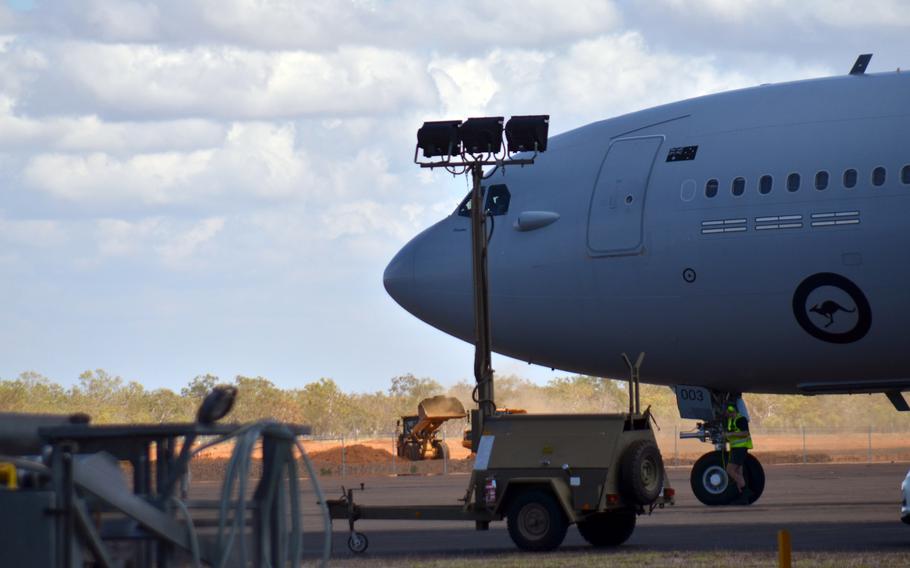
A Royal Australian Air Force plane passes a worksite on RAAF Tindal, Australia, Sept. 1, 2022. The space is being expanded to accommodate aircraft as large as U.S. Air Force B-52 bombers. (Seth Robson/Stars and Stripes)
With little media notice, the United States plans to deploy up to six B-52 strategic bombers to northern Australia. This imposing, and enormously capable, long-range strategic bomber is one of the most durable and respected military aircraft in history.
The B-52 has been a mainstay of the nation’s strategic nuclear bomber force since 1955. Development of Intercontinental Ballistic (ICBM) and Submarine-Launched Ballistic (SLBM) missiles in the 1960s overshadowed but did not remove the need for flexible — including recallable — aircraft. With some irony, the B-52 participated in massive conventional bombing raids during the Vietnam War.
China represents an important, growing challenge to both nations. In 2011, then-President Barack Obama addressed a session of Australia’s parliament, and then-Prime Minister Julia Gillard announced an agreement to station U.S. Marines in that country. The U.S. opposes China’s access to disputed reefs and islands in the South China Sea. Beijing is an aggressively expanding presence in the area. China is already protesting the planned deployment of B-52s as a provocation.
In this tense context, Australia remains a vital U.S. ally. ANZUS, the Australia-New Zealand-U.S. security alliance, was dramatically re-energized by the terrorist attacks of 9/11. Australians were targets in the 2002 terrorist bombings in Bali. In 2004, the Australian Embassy in Jakarta was attacked.
The American-Australian special relationship was forged in the crucible of World War II. In that war, the enormous Japanese military drive south was finally blunted just short of Australia. Knowledgeable jungle-savvy Australian troops provided vital support to generally inexperienced Americans.
The Vietnam War led to strengthening the Australia-United States partnership even while straining U.S. relations with Britain and other allies. A total of 50,000 Australian military personnel served in Vietnam; 520 were killed and 2,400 wounded. Reflecting these pressures, Australia reintroduced military conscription in 1964.
In October 1966, Lyndon B. Johnson became the first U.S. president to visit Australia, underscoring cooperation with Prime Minister Harold Holt. This characteristically dramatic LBJ expedition was undertaken to cast the Vietnam War in global terms.
Australian forces gained valuable guerrilla war experience during the Malaya Emergency from 1948 to 1960 fighting the Malayan National Liberation Army. The insurgency was finally suppressed, confirming the value of long-term patience in employing sustained, carefully directed military force.
President Richard M. Nixon and national security adviser Henry Kissinger tried to apply Malaya insights to Vietnam. Sir Robert Thompson, a highly respected British guerrilla warfare expert, was consulted and provided an encouraging estimate of the prospects of the South Vietnamese military. Gen. Creighton Abrams, after succeeding Gen. William Westmoreland as Vietnam commander, redirected U.S. forces away from massive search-and-destroy operations to small unit actions, reflecting the strategy successfully employed in Malaya. The war strengthened ties between Australia and the U.S. among military and civilian government professionals.
The Afghanistan insurgency was somewhat similar to Malaya and Vietnam. David Kilcullen, a retired Australian army officer, is influential in American security circles. Australians also do humanitarian work in Pakistan and elsewhere.
Australia provides important bridges between developed and developing nations, reflecting historical legacies as well as geography. Rather ironically, the nation’s economy is greatly aided by proximity to China.
In September 2021, Australia, the U.K. and the U.S. announced the new AUKUS partnership. Britain, following departure from the European Union, signed a comprehensive free trade agreement with Australia in December 2021. Australia, Britain and the United States combine deep Asia diplomatic along with military experience, and expertise. Increasingly, the vast Asia region is coming to resemble the Atlantic region as ties grow among democratic nations. In both cases, economic and military dimensions are involved.
In both the Atlantic and Pacific regions, U.S. leadership has proven vital — and successful — over the long term in maintaining peace and promoting growth.
Arthur I. Cyr is author of “After the Cold War.”